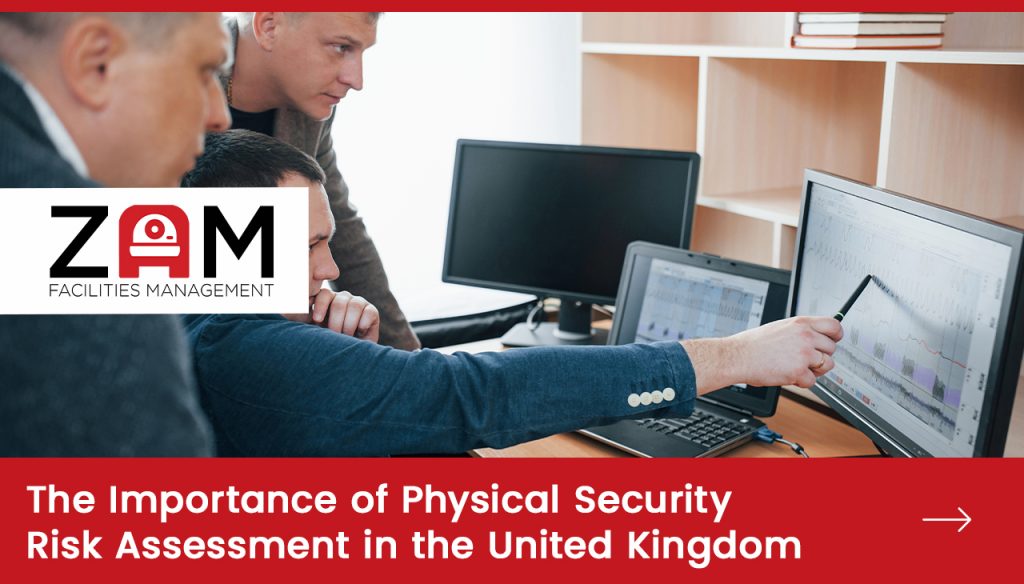In today’s uncertain world, physical security threats can arise at any time and in any place. From terrorism to vandalism to theft, organisations across the United Kingdom face diverse risks that can disrupt operations, endanger employees and assets, and result in substantial financial losses. Conducting thorough physical security risk assessments has thus become an indispensable part of managing these threats and vulnerabilities for all public and private sector organisations.
In this blog post, we will examine why regular physical security risk assessments are vital for UK organisations. We will examine some of the industry sectors’ most pressing threats, from retail to critical infrastructure. We will also explore the key elements of an effective security risk assessment methodology that considers site vulnerabilities, existing countermeasures, threat likelihood, and potential impacts.
We will discuss how organisations can use risk assessment insights to invest in personnel, technology, training, and procedures to mitigate risks and build more resilient security postures aligned to their specific operational profiles. The blog will also discuss risk assessment standards and regulations that UK organisations must comply with.
Public spaces and workplaces across the United Kingdom face an ever-evolving spectrum of physical security threats, from schools to hospitals to transportation hubs. By taking a closer look at how to conduct pragmatic risk assessments, this blog aims to provide actionable guidance to security managers, facility managers, and organisational leaders on better understanding and addressing their unique risk landscapes. A robust security risk assessment provides the foundation for making a UK organisation’s people, assets, and operations more safe and secure against internal and external threats.
Blog Outline
ToggleWhat is a Physical Security Risk Assessment?
A physical security assessment systematically evaluates the vulnerabilities and risks posed to a facility or organisation by external and internal threats. It identifies deficiencies in physical measures designed to protect people, data, equipment, networks, property and company assets.
The assessment examines the effectiveness of existing security controls. It analyses the probability and impact of threats based on site visibility, area crime statistics, potential loss of life, and economic impact.
Qualified security professionals use various techniques to conduct the assessment – from simply observing a facility’s physical security measures to more complex methods like attempting unauthorised access, surveys and audits.
Related Article: Why Security Officers are Vital for Retail Stores
The outputs of the assessment are key: detailed recommendations to improve physical security measures and reduce organisational risk exposure. Recommendations may cover access control, perimeter security, surveillance systems, site lighting, personnel security procedures, and more.
Benefits of Physical Security Risk Assessments
Regular physical security assessments offer manifold benefits:
Improving Business Resilience and Risk Management:
Physical security vulnerabilities can severely impact an organisation’s ability to operate and recover from unexpected events successfully. Assessing risks allows organisations to gain a quantified understanding of threats, minimise weaknesses, and implement appropriate countermeasures – thereby improving resilience.
Understanding of Risk:
Risk assessments produce a measured understanding of vulnerabilities, threats, and potential business impacts. Management can then make better-informed decisions on security strategies, budgets, and implementations.
Vulnerability Identification and Remediation:
Assessments pinpoint physical and procedural vulnerabilities and security gaps. Organisations can develop executive plans and allocate resources to fix them, significantly reducing risk exposure.
Cost Mitigation:
Solid security risk management via assessments can reduce the financial impacts of theft, fraud, vandalism, and business disruption. The costs of improving physical security are small compared to the expense of dealing with incidents after they occur.
Regulatory Compliance:
Many UK industry sectors have regulations mandating periodic physical security risk assessments, like the international ISO 27001 information security standard. Compliance audits are more accessible to pass after acting on assessment recommendations.
Informed Decision Making:
Assessment outputs allow management to make strategic, risk-based decisions on physical security expenditures, like upgrades, training, and resource allocation. Budgets can be optimised and justified.
In summary, physical security assessments are indispensable for minimising organisational exposure to risk, managing threats, optimising security budgets, and bolstering resilience. They produce actionable information to develop security strategies tuned to an organisation’s risk profile.
Steps to a Complete Physical Risk Security Assessment
Conducting a systematic and comprehensive physical security risk assessment involves several key steps:
Inspect Your Facilities and Sites:
This first stage examines an organisation’s physical locations and perimeter areas to evaluate existing security measures subjectively. Site plans, maps, and architectural drawings assist analysis. Areas of concern like entry points, lighting, fencing, alarms, and surveillance are inspected. Building exteriors and interiors are surveyed for vulnerable areas.
Identify Your Risk Factors:
The next step is cataloging assets, analysing site populations, and identifying specific organisational risks. Critical assets and sensitive information requiring protection must be inventoried. Potential threats, probabilities, and loss impacts are determined. Crime rates for surrounding areas are reviewed. Past incidents are analysed.
Audit Your Physical Security Systems:
Technical security systems like access control, CCTV monitoring, alarms, sensors, and communication systems are thoroughly audited to test functionality, coverage, and maintenance. Capabilities are compared to regulatory standards. Vulnerabilities like faulty equipment or inadequate coverage are highlighted.
Review Your Operating Procedures:
Existing standard operating procedures for access control, surveillance monitoring, maintenance, and incident response are reviewed. Personnel security procedures like ID checks and visitor processing are audited. Gaps and inconsistencies in procedures are identified.
Assess Physical Security Risks:
All data gathered from inspections, audits and reviews is collated into a formal risk assessment report. Risk analysis ratings can be qualitative or quantitative, depending on organisational needs. Specific recommendations to mitigate identified vulnerabilities are provided based on risk levels, costs, and management priorities.
In summary, a comprehensive physical security assessment examines an organisation’s facilities, assets, systems, and procedures to provide invaluable insights into strengthening protection against internal and external threats. The output risk analysis provides a framework for continuous improvement.
Conclusion
Regular physical security risk assessments have become vital for today’s organisations operating in a complex threat landscape. Assessments methodically identify vulnerabilities and evaluate risks, producing actionable recommendations that reduce exposure. They provide the foundation for building robust and resilient security postures tailored to specific risks.
